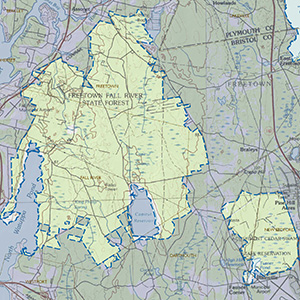Important Bird Area Sites in Massachusetts
Important Bird Area: Freetown State Forest & Southeastern MA Bioreserve
Site Summary
Nominated By
Jack Lash
Size
15,000 acres
Towns and Counties
Freetown, Fall River; Bristol
Ownership
state, municipal, The Trustees of Reservations
Major Habitats
northern hardwoods forest, oak-conifer forest, pitch pine/scrub oak, early successional shrubland, power line, shrub-scrub wetland, River/stream, migratory stopover site
Land Use
nature & wildlife, conservation/land trust, hunting & fishing, other rec., forestry, quarry/ gravel pit, etc., water supply, utility/ right-of-way, suburban/ residential,research
IBA Criteria
- Category 1: Sites important for long-term research and/or monitoring projects that contribute substantially to ornithology, bird conservation, and/or education.
- Category 2: Sites containing assemblages of species characteristic of a representative, rare, threatened, or unique habitat within the state or region.
- Category 4: Single-species Concentrations: The site regularly supports significant concentrations of a flocking species, but may not meet the thresholds above. The site should support a higher proportion of a species' statewide population (more than 1%, if known) than other similar sites.
- Category 5: Land Birds: The site is an important migratory stopover or seasonal concentration site for migratory land birds (e.g., warblers). Sites may also qualify on the basis of supporting exceptionally high densities of breeding species as shown from point counts or other surveys or if they represent "migrant traps" relative to surrounding areas. Strong consideration will be given to areas with consistently high overall species diversity.
Site Description
This IBA includes a large contiguous acreage comprising forest of various successional stages, and wetlands, including a 5,500-acre Massachusetts state forest as well as a similar-sized cedar swamp, a municipal public water supply, and both public and nonprofit protected areas. Because the area has received designation as a bioreserve, there is increased interest in habitat management, research, and monitoring of flora and fauna.
Current Conservation Status
The area includes the Freetown State Forest, along with the entire 14,000-acre Southeastern Massachusetts Bioreserve. The Freetown State Forest and Acushnet Cedar Swamp are operated and owned by the Massachusetts Department of Conservation and Recreation (DCR). In addition to DCR several other local and state and nongovernmental organizations are landowners; and partners are involved in the study and management of the bioreserve, including MassWildlife, The Trustees of Reservations (TTOR), and the city of Fall River. Primary threats pertain to occasional ORV and ATV use, invasive species, and Brown-Headed Cowbirds. Access to waterfowl counts and other studies are limited by public water supply regulations. An adjacent quarry tied in with Boston's "Big Dig" project is very active. Housing abutting public land is increasing annually. Road salt from the adjacent highway is affecting northwestern portions of the bioreserve and Rattlesnake Brook.
Ornithological Significance
At least seven regional, and one species having high conservation priority in Massachusetts breed within this area in high concentrations (e.g. Eastern Towhee 60, 1994 2000): Ovenbird, and Prairie Warbler 35, 1994 2000). Birders have visited the bioreserve during Christmas Bird Counts (CBC), spring migration bird counts. Breeding Bird Surveys (BBS) and recent Biodiversity Day events. CBCs and BBSs have been conducted since 1970. In lieu of recent Bioreserve disignations, monitoring studies on permanent plots are in place. Norther Parula has been reported several times in recent years. Overall, the state forest supports important avian habitat diversity, especially the Rattlesnake Brook area. The area is also due to its significant wetland habitats.
Other Flora or Fauna of Significance
Eastern Box Turtles (special concern) and Spotted Salamanders have been recently confirmed at this site, and the Mystic Valley Amphipod, a freshwater crustacean, also occurs at the Acushnet Cedar Swamp. Rare flora include; Small Yellow Lady's Slipper (endangered), Heartleaf Twayblade (endangered), and Climbing Fern (special concern).
Data Sources
Most data are from the South Shore Bird Club, MassWildlife District Biologists, personal observations by local birders, and tallies by Epsilon Associates, an EOEA-contracted consulting group. Data are also from migratory counts, BBs: CBCs, and presence/absence counts by DCR staff. Breeding species confirmed by Veit & Petersen, DeGraff, et al.




